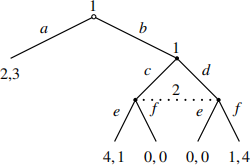ECON 2112. PRACTICE EXERCISES
Hello, dear friend, you can consult us at any time if you have any questions, add WeChat: daixieit
ECON 2112. PRACTICE EXERCISES
Exercise 1. Consider the following game: Two players have to simultaneously announce one integer between 0 and 100. If the sum of both integers is 101 or larger, the player who announced the smallest number wins. If the sum of both integers is 100 or smaller, the player who announced the largest number wins. The player who loses has to pay the winner the winner’s announcement in dollars. If both players announce the same integer then they tie and no money changes hands.
(i) Identify players, strategy sets and payof functions.
(ii) Do players have a strategy that guarantee that they never lose money?
(iii) Is there a strictly or weakly dominated strategy?
(iv) Find the set of Nash equilibria.
(v) Can we solve the game (reduce it to a single strategy proile) using iterated deletion of strictly dominated strategies?
Exercise 2. Compute the set of subgame perfect equilibria of the following game.

Exercise 3. Compute the set of subgame perfect equilibria of the following game.

Exercise 4. What is the set of Nash equilibria of the following game?

Exercise 5. Consider the twice repeated prisoner’s dilemma: two players have to play the prisoner’s dilemma twice. After they play the irst time, payments are made and each player knows whether or not the other player has confessed. Then they play the prisoner’s dilemma a second time. In each stage, moves are made simultaneously.
![]() What is the subgame perfect equilibrium?
What is the subgame perfect equilibrium?
![]() What is the subgame perfect equilibrium if the prisoner’s dilemma is repeated three times?
What is the subgame perfect equilibrium if the prisoner’s dilemma is repeated three times? ![]() And if it is repeated T times? (T is any inite positive integer).
And if it is repeated T times? (T is any inite positive integer).
Exercise 6 (Di伍cult). Consider the following modiication of the prisoner’s dilemma game.

You should recognise the payo![]() s from (A, L), (A, R), (B, L), (B, R) as those in the prisoner’s dilemma game studied in class. We added two strategies, one for each player. Also note that strategies A and L are still (when compared to the original prisoner’s dilemma game) strictly dominated.
s from (A, L), (A, R), (B, L), (B, R) as those in the prisoner’s dilemma game studied in class. We added two strategies, one for each player. Also note that strategies A and L are still (when compared to the original prisoner’s dilemma game) strictly dominated.
![]() What is the set of Nash equilibria of this game.
What is the set of Nash equilibria of this game.
![]() Suppose that the two players play this game twice. After they play the irst time, payments are
Suppose that the two players play this game twice. After they play the irst time, payments are
made and each player knows the action chosen by the other player. Then they play a second time. Is there a subgame perfect equilibrium where players play (A, L) the irst time the play the game? (For simplicity you may focus on subgame perfect equilibria where players do not use randomised choices.)
2023-04-27